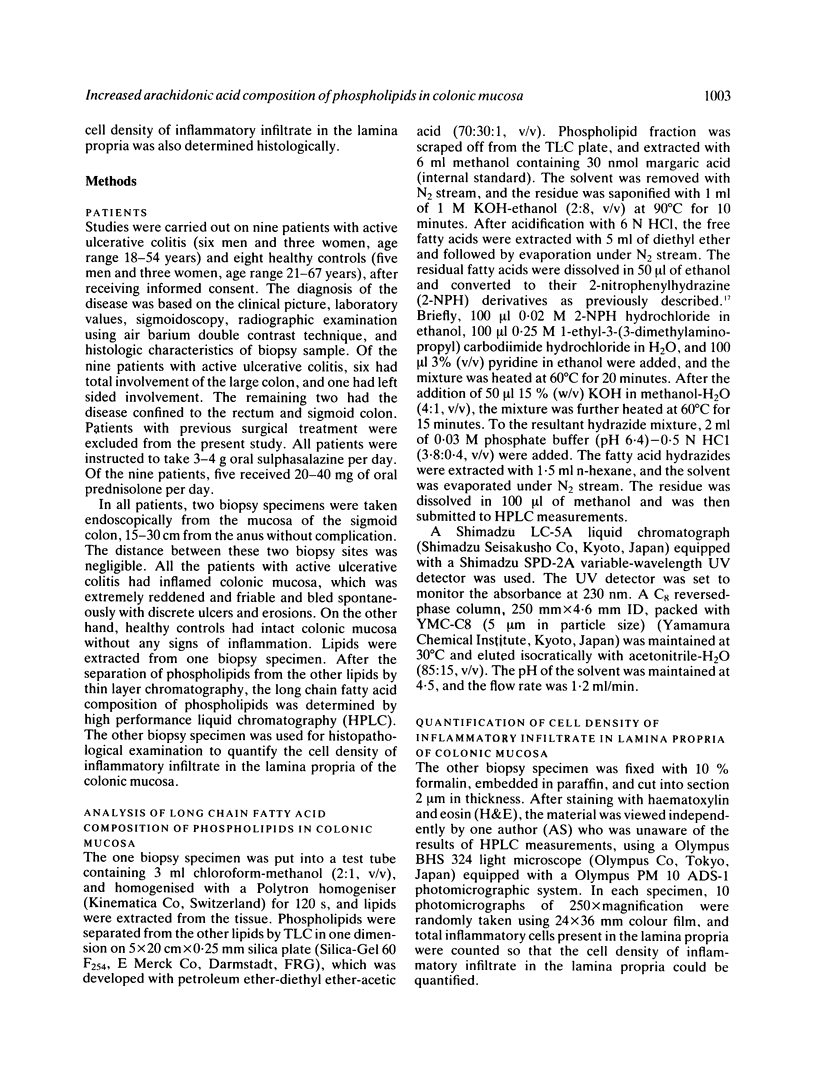Abstract
The long chain fatty acid composition of phospholipids in colonic mucosa was determined by high performance liquid chromatography in nine patients with active ulcerative colitis and eight healthy controls. The arachidonic acid composition was 12.5 +/- 1.4 mol % (mean +/- 2 SEM) in the inflamed colonic mucosa from the patients with active ulcerative colitis and 6.8 +/- 1.2 mol % in the intact mucosa from healthy controls (p less than 0.001). In the inflamed colonic mucosa, oleic acid and palmitoleic acid were concomitantly decreased (p less than 0.001 and p less than 0.02, respectively), while docosahexaenoic acid was increased (p less than 0.05). Histopathological examination showed that there was a three fold increase in the cell density of inflammatory infiltrate in the lamina propria of the inflamed colonic mucosa (p less than 0.001). The cell density of inflammatory infiltrate correlated with the arachidonic acid composition of phospholipids in colonic mucosa (r = 0.89, p less than 0.005). These findings indicate that inflammation alters the long chain fatty acid composition of phospholipids in colonic mucosa. The observed increase in the arachidonic acid composition of phospholipids in inflamed colonic mucosa may contribute to the enhanced arachidonic acid metabolism in patients with active ulcerative colitis.
Full text
PDF





Selected References
These references are in PubMed. This may not be the complete list of references from this article.
- Cherayil G. D. Sialic acid and fatty acid concentrations in lymphocytes, red blood cells and plasma from patients with multiple sclerosis. J Neurol Sci. 1984 Jan;63(1):1–10. doi: 10.1016/0022-510x(84)90104-7. [DOI] [PubMed] [Google Scholar]
- Cockcroft S., Allan D. The fatty acid composition of phosphatidylinositol, phosphatidate and 1,2-diacylglycerol in stimulated human neutrophils. Biochem J. 1984 Sep 1;222(2):557–559. doi: 10.1042/bj2220557. [DOI] [PMC free article] [PubMed] [Google Scholar]
- Compston J. E., Horton L. W., Laker M. F., Ayers A. B., Woodhead J. S., Bull H. J., Gazet J. C., Pilkington T. R. Bone disease after jejuno-ileal bypass for obesity. Lancet. 1978 Jul 1;2(8079):1–4. doi: 10.1016/s0140-6736(78)91318-1. [DOI] [PubMed] [Google Scholar]
- DeLong E. F., Yayanos A. A. Adaptation of the membrane lipids of a deep-sea bacterium to changes in hydrostatic pressure. Science. 1985 May 31;228(4703):1101–1103. doi: 10.1126/science.3992247. [DOI] [PubMed] [Google Scholar]
- Donabedian R. K., Karmen A. Fatty acid transport and incorporation into human erythrocytes in vitro. J Clin Invest. 1967 Jun;46(6):1017–1027. doi: 10.1172/JCI105591. [DOI] [PMC free article] [PubMed] [Google Scholar]
- Donowitz M. Arachidonic acid metabolites and their role in inflammatory bowel disease. An update requiring addition of a pathway. Gastroenterology. 1985 Feb;88(2):580–587. doi: 10.1016/0016-5085(85)90525-6. [DOI] [PubMed] [Google Scholar]
- Flower R. J., Blackwell G. J. Anti-inflammatory steroids induce biosynthesis of a phospholipase A2 inhibitor which prevents prostaglandin generation. Nature. 1979 Mar 29;278(5703):456–459. doi: 10.1038/278456a0. [DOI] [PubMed] [Google Scholar]
- Ford-Hutchinson A. W., Bray M. A., Doig M. V., Shipley M. E., Smith M. J. Leukotriene B, a potent chemokinetic and aggregating substance released from polymorphonuclear leukocytes. Nature. 1980 Jul 17;286(5770):264–265. doi: 10.1038/286264a0. [DOI] [PubMed] [Google Scholar]
- Gould S. R., Brash A. R., Conolly M. E., Lennard-Jones J. E. Studies of prostaglandins and sulphasalazine in ulcerative colitis. Prostaglandins Med. 1981 Feb;6(2):165–182. doi: 10.1016/0161-4630(81)90088-4. [DOI] [PubMed] [Google Scholar]
- Hagve T. A., Christophersen B. O. Effect of dietary fats on arachidonic acid and eicosapentaenoic acid biosynthesis and conversion to C22 fatty acids in isolated rat liver cells. Biochim Biophys Acta. 1984 Nov 14;796(2):205–217. doi: 10.1016/0005-2760(84)90349-7. [DOI] [PubMed] [Google Scholar]
- Harris D. W., Smith P. R., Swan C. H. Determination of prostaglandin synthetase activity in rectal biopsy material and its significance in colonic disease. Gut. 1978 Oct;19(10):875–877. doi: 10.1136/gut.19.10.875. [DOI] [PMC free article] [PubMed] [Google Scholar]
- Irvine R. F. How is the level of free arachidonic acid controlled in mammalian cells? Biochem J. 1982 Apr 15;204(1):3–16. doi: 10.1042/bj2040003. [DOI] [PMC free article] [PubMed] [Google Scholar]
- LANDS W. E., HART P. METABOLISM OF GLYCEROLIPIDS. VI. SPECIFICITIES OF ACYL COENZYME A: PHOSPHOLIPID ACYLTRANSFERASES. J Biol Chem. 1965 May;240:1905–1911. [PubMed] [Google Scholar]
- Lewis R. A., Austen K. F. The biologically active leukotrienes. Biosynthesis, metabolism, receptors, functions, and pharmacology. J Clin Invest. 1984 Apr;73(4):889–897. doi: 10.1172/JCI111312. [DOI] [PMC free article] [PubMed] [Google Scholar]
- Marcus A. J. Eicosanoids as bioregulators in clinical medicine. Am J Med. 1985 May;78(5):805–810. doi: 10.1016/0002-9343(85)90287-6. [DOI] [PubMed] [Google Scholar]
- Marcus A. J. The eicosanoids in biology and medicine. J Lipid Res. 1984 Dec 15;25(13):1511–1516. [PubMed] [Google Scholar]
- Miwa H., Yamamoto M. Improved method of determination of biologically important C10:0-C22:6 fatty acids as their 2-nitrophenylhydrazides by reversed-phase high-performance liquid chromatography. J Chromatogr. 1986 Jan 17;351(2):275–282. doi: 10.1016/s0021-9673(01)83497-x. [DOI] [PubMed] [Google Scholar]
- Miyazaki H., Kawasaki H., Hirayama C. Studies on lymphocyte subpopulations in human colonic biopsy specimens by colonoscopy. Dig Dis Sci. 1985 Feb;30(2):143–148. doi: 10.1007/BF01308201. [DOI] [PubMed] [Google Scholar]
- Morson B. C. Rectal biopsy in inflammatory bowel disease. N Engl J Med. 1972 Dec 28;287(26):1337–1339. doi: 10.1056/NEJM197212282872607. [DOI] [PubMed] [Google Scholar]
- Reitz R. C., el-Sheikh M., Lands W. M., Ismail I. A., Gunstone F. D. Effects of ethylenic bond position upon acyltransferase activity with isomeric cis-octadecenoyl coenzyme A thiol esters. Biochim Biophys Acta. 1969 Apr 29;176(3):480–490. doi: 10.1016/0005-2760(69)90215-x. [DOI] [PubMed] [Google Scholar]
- Samuelsson B. Leukotrienes: mediators of immediate hypersensitivity reactions and inflammation. Science. 1983 May 6;220(4597):568–575. doi: 10.1126/science.6301011. [DOI] [PubMed] [Google Scholar]
- Sharon P., Ligumsky M., Rachmilewitz D., Zor U. Role of prostaglandins in ulcerative colitis. Enhanced production during active disease and inhibition by sulfasalazine. Gastroenterology. 1978 Oct;75(4):638–640. [PubMed] [Google Scholar]
- Sharon P., Stenson W. F. Enhanced synthesis of leukotriene B4 by colonic mucosa in inflammatory bowel disease. Gastroenterology. 1984 Mar;86(3):453–460. [PubMed] [Google Scholar]
- Stenson W. F., Lobos E. Sulfasalazine inhibits the synthesis of chemotactic lipids by neutrophils. J Clin Invest. 1982 Feb;69(2):494–497. doi: 10.1172/JCI110474. [DOI] [PMC free article] [PubMed] [Google Scholar]
- Zeitlin I. J., Smith A. N. Mobilization of tissue kallikrein in inflammatory disease of the colon. Gut. 1973 Feb;14(2):133–138. doi: 10.1136/gut.14.2.133. [DOI] [PMC free article] [PubMed] [Google Scholar]


